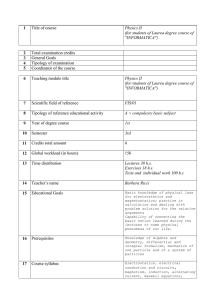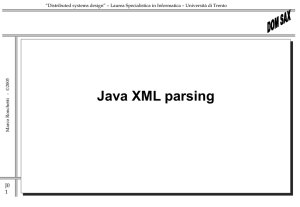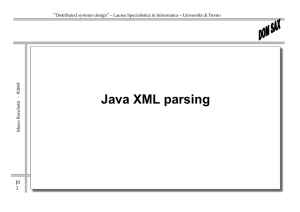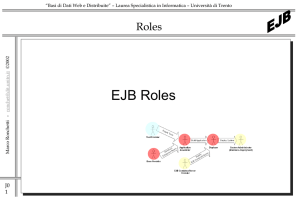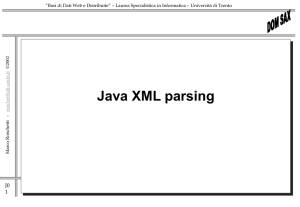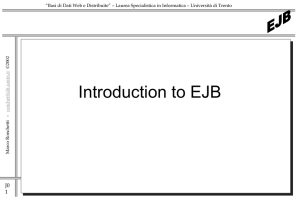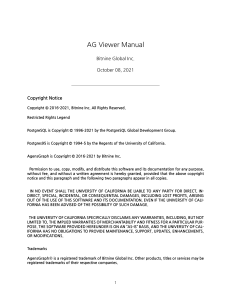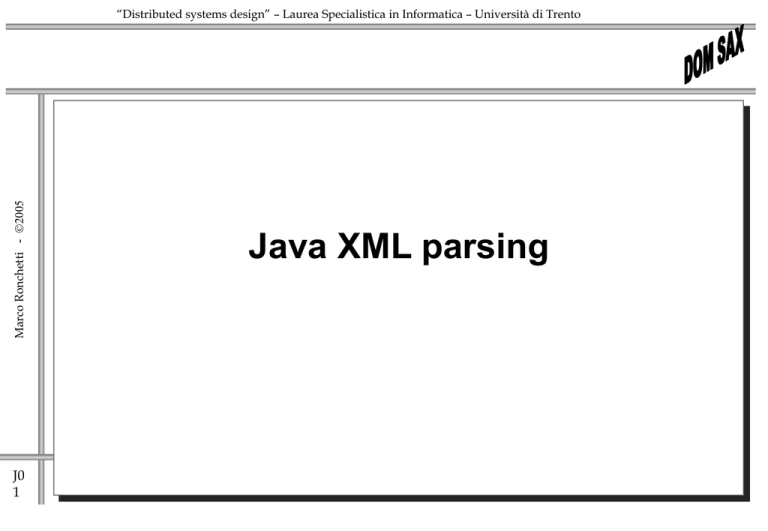
Marco Ronchetti -
“Distributed systems design” – Laurea Specialistica in Informatica – Università di Trento
J0
1
Java XML parsing
“Distributed systems design” – Laurea Specialistica in Informatica – Università di Trento
Tree-based vs Event-based API
Marco Ronchetti -
Tree-based API
J0
2
A tree-based API compiles an XML document into an internal
tree structure. This makes it possible for an application
program to navigate the tree to achieve its objective. The
Document Object Model (DOM) working group at the W3C is
developing a standard tree-based API for XML.
Event-based API
An event-based API reports parsing events (such as the start
and end of elements) to the application using callbacks. The
application implements and registers event handlers for the
different events. Code in the event handlers is designed to
achieve the objective of the application. The process is similar
(but not identical) to creating and registering event listeners in
the Java Delegation Event Model.
“Distributed systems design” – Laurea Specialistica in Informatica – Università di Trento
what is SAX?
Marco Ronchetti -
SAX is a set of interface definitions
For the most part, SAX is a set of interface definitions. They
specify one of the ways that application programs can interact
with XML documents.
J0
3
(There are other ways for programs to interact with XML documents
as well. Prominent among them is the Document Object Model,
or DOM)
SAX is a standard interface for event-based XML parsing, developed
collaboratively by the members of the XML-DEV mailing list. SAX
1.0 was released on Monday 11 May 1998, and is free for both
commercial and noncommercial use.
The current version is SAX 2.0.1 (released on 29-January 2002)
See http://www.saxproject.org/
“Distributed systems design” – Laurea Specialistica in Informatica – Università di Trento
JAXP
Marco Ronchetti -
JAXP: Java API for XML Processing
This API provides a common interface for creating and using the
standard SAX, DOM, and XSLT APIs in Java, regardless of which
vendor's implementation is actually being used.
The main JAXP APIs are defined in the javax.xml.parsers package.
That package contains two vendor-neutral factory classes:
SAXParserFactory and DocumentBuilderFactory that give you a
SAXParser and a DocumentBuilder, respectively. The
DocumentBuilder, in turn, creates DOM-compliant Document
object.
The actual binding to a DOM or SAX engine can be specified using
the System properties (but a default is provided).
J0
4
“Distributed systems design” – Laurea Specialistica in Informatica – Università di Trento
JAXP – other packages
org.xml.sax
Defines the basic SAX APIs.
Marco Ronchetti -
The "Simple API" for XML (SAX) is the event-driven, serial-access
mechanism that does element-by-element processing. The API for this
level reads and writes XML to a data repository or the Web.
org.w3c.dom
Defines the Document class (a DOM), as well as
classes for all of the components of a DOM.
The DOM API is generally an easier API to use. It provides a familiar tree
structure of objects. You can use the DOM API to manipulate the hierarchy
of application objects it encapsulates. The DOM API is ideal for interactive
applications because the entire object model is present in memory, where it
can be accessed and manipulated by the user.
On the other hand, constructing the DOM requires reading the entire XML
structure and holding the object tree in memory, so it is much more CPU
and memory intensive.
javax.xml.transform
Defines the XSLT APIs that let you
transform XML into other forms.
J0
5
“Distributed systems design” – Laurea Specialistica in Informatica – Università di Trento
SAX architecture
SAXParserFactory factory = SAXParserFactory.newInstance();
factory.setValidating(true); //optional - default is non-validating
Marco Ronchetti -
SAXParser saxParser = factory.newSAXParser();
saxParser.parse(File f, DefaultHandler-subclass h)
File containing
input XML
wraps
Default-handler
(classe che
implementa le
callback)
Interfaces implemented
by DefaultHandler class
J0
6
“Distributed systems design” – Laurea Specialistica in Informatica – Università di Trento
SAX packages
Package
Marco Ronchetti -
org.xml.sax
J0
7
org.xml.sax.ext
Description
Defines the SAX interfaces. The name "org.xml" is the package
prefix that was settled on by the group that defined the SAX API.
Defines SAX extensions that are used when doing more
sophisticated SAX processing, for example, to process a document
type definitions (DTD) or to see the detailed syntax for a file.
org.xml.sax.hel
pers
Contains helper classes that make it easier to use SAX -- for
example, by defining a default handler that has null-methods for all
of the interfaces, so you only need to override the ones you actually
want to implement.
javax.xml.parse
rs
Defines the SAXParserFactory class which returns the SAXParser.
Also defines exception classes for reporting errors.
“Distributed systems design” – Laurea Specialistica in Informatica – Università di Trento
Marco Ronchetti -
SAX callbacks
J0
8
// ----------------------------- ContentHandler methods
void characters(char[] ch, int start, int length)
void startDocument()
void startElement(String name, AttributeList attrs)
void endElement(String name)
void endDocument()
void processingInstruction(String target,String data)
“Distributed systems design” – Laurea Specialistica in Informatica – Università di Trento
Typical SAX scheleton
Marco Ronchetti -
import java.io.*;
import org.xml.sax.*;
import javax.xml.parsers.SAXParserFactory;
import javax.xml.parsers.SAXParser;
J0
9
public class MyClass extends DefaultHandler {
public static void main(String argv[]) throws Exception {
if (argv.length != 1) {
System.err.println("Usage: cmd filename");
System.exit(1);
}
Obtain a SAX parser,
// JAXP methods
Parse the file
SAXParserFactory factory = SAXParserFactory.newInstance();
SAXParser saxParser = factory.newSAXParser();
saxParser.parse(new File(argv[0]), new MyClass());
}
“Distributed systems design” – Laurea Specialistica in Informatica – Università di Trento
Marco Ronchetti -
SAX example 1
J0
10
package jaxp_demo;
import java.io.*;
import org.xml.sax.helpers.DefaultHandler;
import javax.xml.parsers.SAXParserFactory;
import javax.xml.parsers.SAXParser;
public class Echo01
{
public static void main(String argv[])
{
if (argv.length != 1) {
System.err.println("Usage: cmd filename");
System.exit(1);
}
new Echo01(argv[0]);
}
“Distributed systems design” – Laurea Specialistica in Informatica – Università di Trento
Marco Ronchetti -
SAX example 1
J0
11
public Echo01(String filename) {
DefaultHandler handler = new MySaxHandler();
// Use the default (non-validating) parser
SAXParserFactory factory = SAXParserFactory.newInstance();
try {
SAXParser saxParser = factory.newSAXParser();
saxParser.parse( new File(filename), handler);
} catch (Throwable t) {
Obtain a SAX parser,
t.printStackTrace();
Parse the file
}
System.exit(0);
}
}
“Distributed systems design” – Laurea Specialistica in Informatica – Università di Trento
Marco Ronchetti -
SAX example 1
J0
12
package jaxp_demo;
import org.xml.sax.helpers.DefaultHandler;
import org.xml.sax.*;
import java.io.*;
public class MySaxHandler extends DefaultHandler {
int indentCount=0;
String indentString="
";
private PrintStream out = System.out;
private void emit(String s) {
out.print(s);
Utility methods
out.flush();
}
private void nl() {
String lineEnd = System.getProperty("line.separator");
out.print(lineEnd);
}
private void indent(){
String s="";
for (int i=1;i<=indentCount;i++) s=s+indentString;
out.print(s);
}
“Distributed systems design” – Laurea Specialistica in Informatica – Università di Trento
SAX example 1
Marco Ronchetti -
//==========================================================
// SAX DocumentHandler methods
//==========================================================
J0
13
public void startDocument() throws SAXException {
emit("<?xml version='1.0' encoding='UTF-8'?>");
nl();
}
public void endDocument() throws SAXException {
nl();
out.flush();
}
“Distributed systems design” – Laurea Specialistica in Informatica – Università di Trento
Marco Ronchetti -
SAX example 1
J0
14
public void startElement(String namespaceURI,
String lName, // local name
String qName, // qualified name
Attributes attrs) throws SAXException {
String eName = lName; // element name
if ("".equals(eName)) eName = qName;
indent();
emit("<" + eName);
if (attrs != null) {
for (int i = 0; i < attrs.getLength(); i++) {
String aName = attrs.getLocalName(i); // Attr name
if ("".equals(aName)) aName = attrs.getQName(i);
emit(" ");
emit(aName + "=\"" + attrs.getValue(i) + "\"");
}
}
emit(">");
nl();
indentCount++;
}
“Distributed systems design” – Laurea Specialistica in Informatica – Università di Trento
Marco Ronchetti -
SAX example 1
public void endElement(String namespaceURI,
String sName, // simple name
String qName // qualified name
) throws SAXException {
indentCount--;
indent();
emit("</" + qName + ">");
nl();
}
public void characters(char buf[], int offset, int len)
throws SAXException {
//String s = new String(buf, offset, len);
//emit(s);
}
}
J0
15
“Distributed systems design” – Laurea Specialistica in Informatica – Università di Trento
SAX references
Marco Ronchetti -
A full tutorial with more info and details
J0
16
http://java.sun.com/webservices/jaxp/dist/1.1/docs/
tutorial/sax/index.html
“Distributed systems design” – Laurea Specialistica in Informatica – Università di Trento
Marco Ronchetti -
DOM architecture
J0
17
DocumentBuilderFactory dbf = DocumentBuilderFactory.newInstance();
dbf.setValidating(true); // optional – default is non-validating
DocumentBuilder db = dbf.newDocumentBuilder();
Document doc = db.parse(file);
“Distributed systems design” – Laurea Specialistica in Informatica – Università di Trento
DOM packages
Package
Marco Ronchetti -
org.w3c.dom
J0
18
javax.xml.parsers
Description
Defines the DOM programming interfaces for XML (and,
optionally, HTML) documents, as specified by the W3C.
Defines the DocumentBuilderFactory class and the
DocumentBuilder class, which returns an object that implements
the W3C Document interface. The factory that is used to create the
builder is determined by the javax.xml.parsers system property,
which can be set from the command line or overridden when
invoking the newInstance method. This package also defines the
ParserConfigurationException class for reporting errors.
“Distributed systems design” – Laurea Specialistica in Informatica – Università di Trento
Marco Ronchetti -
The Node interface
J0
19
public interface Node
The Node interface is the primary datatype for the entire DOM. It
represents a single node in the document tree. While all objects
implementing the Node interface expose methods for dealing with
children, not all objects implementing the Node interface may have
children. For example, Text nodes may not have children, and
adding children to such nodes results in a DOMException being
raised.
The attributes nodeName, nodeValue and attributes are included as a
mechanism to get at node information without casting down to the
specific derived interface. In cases where there is no obvious
mapping of these attributes for a specific nodeType (e.g., nodeValue
for an Element or attributes for a Comment ), this returns null. Note
that the specialized interfaces may contain additional and more
convenient mechanisms to get and set the relevant information.
“Distributed systems design” – Laurea Specialistica in Informatica – Università di Trento
The Document interface
Marco Ronchetti -
public interface Document extends Node
J0
20
The Document interface represents the entire HTML or XML document.
Conceptually, it is the root of the document tree, and provides the primary
access to the document's data. Since elements, text nodes, comments,
processing instructions, etc. cannot exist outside the context of a
Document, the Document interface also contains the factory methods
needed to create these objects. The Node objects created have a
ownerDocument attribute which associates them with the Document within
whose context they were created.
“Distributed systems design” – Laurea Specialistica in Informatica – Università di Trento
The Node hierarchy
Marco Ronchetti -
Node
Document
Entity
CharacterData
Attr
Comment
Text
mydocument
<!-- Demo -->
<A id=“3”>hello</A>
J0
21
comment
A
Demo
hello
id=“3”
“Distributed systems design” – Laurea Specialistica in Informatica – Università di Trento
The Node hierarchy
Marco Ronchetti -
Node
Document
DocumentType
DocumentFragment
EntityReference
Entity
Attr
ProcessingInstruction
Notation CharacterData
Comment
Text
CDATASection
J0
22
“Distributed systems design” – Laurea Specialistica in Informatica – Università di Trento
Marco Ronchetti -
Node: WARNING!
J0
23
The implied semantic of this model is
WRONG!
You might deduce that a comment might contain another comment, or
a document, or any other node!
The integrity is delegated to a series of Node’s attributes, that the
programmer should check.
“Distributed systems design” – Laurea Specialistica in Informatica – Università di Trento
Marco Ronchetti -
Node: main methods
J0
24
NAVIGATION
Node getParentNode()
The parent of this node.
NodeList getChildNodes()
A NodeList that contains all children of this node.
Node getFirstChild()
The first child of this node.
Node getLastChild()
The last child of this node.
Node getNextSibling()
.
Node getPreviousSibling()
The node immediately following this node
The node immediately preceding this node.
“Distributed systems design” – Laurea Specialistica in Informatica – Università di Trento
Marco Ronchetti -
The Node interface
J0
25
Interface
nodeName
nodeValue
attributes
Attr
name of attribute
value of attribute
null
CDATASection
"#cdata-section“
content of the CDATA
Section
null
Comment
"#comment“
content of the comment
null
Document
"#document“
null
null
DocumentFragment
"#document-fragment“ null
null
DocumentType
document type name
null
null
Element
tag name
null
NamedNodeMap
Entity
entity name
null
null
EntityReference
name of entity
referenced
null
null
Notation
notation name
null
null
ProcessingInstruction
target
entire content excluding
the target
null
Text
"#text“
content of the text node
null
“Distributed systems design” – Laurea Specialistica in Informatica – Università di Trento
Node: main methods
Marco Ronchetti -
INSPECTION
J0
26
java.lang.String getNodeName()
The name of this node, depending on its type; see table.
short getNodeType()
A code representing the type of the underlying object.
java.lang.String getNodeValue()
The value of this node, depending on its type; see the table.
Document getOwnerDocument()
The Document object associated with this node.
Boolean hasAttributes()
Returns whether this node (if it is an element) has any attributes.
Boolean hasChildNodes()
Returns whether this node has any children.
“Distributed systems design” – Laurea Specialistica in Informatica – Università di Trento
Node: main methods
Marco Ronchetti -
EDITING NODES
Node cloneNode(boolean deep)
Returns a duplicate of this node, i.e., serves as a generic copy constructor
for nodes.
J0
27
void setNodeValue(java.lang.String nodeValue)
The value of this node, depending on its type; see the table.
“Distributed systems design” – Laurea Specialistica in Informatica – Università di Trento
Marco Ronchetti -
Node: main methods
J0
28
EDITING STRUCTURE
Node appendChild(Node newChild)
Adds the node newChild to the end of the list of children of this node.
Node removeChild(Node oldChild)
Removes the child node indicated by oldChild from the list of children, and
returns it.
Node replaceChild(Node newChild, Node oldChild)
Replaces the child node oldChild with newChild in the list of children, and
returns the oldChild node.
Node insertBefore(Node newChild, Node refChild)
Inserts the node newChild before the existing child node refChild.
void normalize()
Puts all Text nodes in the full depth of the sub-tree underneath this Node,
including attribute nodes, into a "normal" form where only structure (e.g., elements,
comments, processing instructions, CDATA sections, and entity references)
separates Text nodes, i.e., there are neither adjacent Text nodes nor empty Text
nodes.
“Distributed systems design” – Laurea Specialistica in Informatica – Università di Trento
Marco Ronchetti -
NODE: determining the type
J0
29
switch (node.getNodeType()) {
case Node.ELEMENT_NODE; …; break;
case Node.ATTRIBUTE_NODE; …; break;
case Node.TEXT_NODE; …; break;
case Node.CDATA_SECTION_NODE; …; break;
case Node.ENTITY_REFERENCE_NODE; …; break;
case Node.PROCESSING_INSTRUCTION; …; break;
case Node.COMMENT_NODE; …; break;
case Node.DOCUMENT_NODE; …; break;
case Node.DOCUMENT_TYPE_NODE; …; break;
case Node.DOCUMENT_FRAGMENT_NODE; …; break;
case Node.NOTATION_NODE; …; break;
default: throw (new Exception());
}
“Distributed systems design” – Laurea Specialistica in Informatica – Università di Trento
Marco Ronchetti -
DOM example
J0
30
import java.io.*;
import org.w3c.dom.*;
import org.xml.sax.*; // parser uses SAX methods to build DOM object
import javax.xml.parsers.DocumentBuilderFactory;
import javax.xml.parsers.DocumentBuilder;
public class CountDom {
public static void main(String[ ] arg) throws Exception {
if (arg.length != 1) {
System.err.println("Usage: cmd filename (file must exist)");
System.exit(1);
}
Node node = readFile(new File(arg[0]));
System.out.println(arg + " elementCount: " + getElementCount(node));
}
}
“Distributed systems design” – Laurea Specialistica in Informatica – Università di Trento
Marco Ronchetti -
DOM example
J0
31
public static Document readFile(File file) throws Exception {
Document doc;
Parse File,
try {
Return Document
DocumentBuilderFactory dbf = DocumentBuilderFactory.newInstance();
dbf.setValidating(false);
DocumentBuilder db = dbf.newDocumentBuilder();
doc = db.parse(file);
return doc;
} catch (SAXParseException ex) {
throw (ex);
} catch (SAXException ex) {
Exception x = ex.getException(); // get underlying Exception
throw ((x == null) ? ex : x);
}
}
“Distributed systems design” – Laurea Specialistica in Informatica – Università di Trento
DOM example
Marco Ronchetti -
public static int getElementCount(Node node) {
if (null == node)
return 0;
int sum = 0;
boolean isElement = (node.getNodeType() == Node.ELEMENT_NODE);
if (isElement) sum = 1;
NodeList children = node.getChildNodes();
if (null == children)
return sum;
}
J0
32
for (int i = 0; i < children.getLength(); i++) {
sum += getElementCount(children.item(i)); // recursive call
}
use DOM methods to count elements:
return sum;
for each subtree if the root is an Element,
}
set sum to 1, else to 0;
add element count of all children of the root to sum
“Distributed systems design” – Laurea Specialistica in Informatica – Università di Trento
Marco Ronchetti -
Alternatives to DOM
J0
33
"Build a better mousetrap, and the world will
beat a path to your door."
--Emerson
“Distributed systems design” – Laurea Specialistica in Informatica – Università di Trento
Alternatives to DOM
Marco Ronchetti -
JDOM: Java DOM (see http://www.jdom.org).
The standard DOM is a very simple data structure that intermixes text
nodes, element nodes, processing instruction nodes, CDATA nodes,
entity references, and several other kinds of nodes. That makes it
difficult to work with in practice, because you are always sifting through
collections of nodes, discarding the ones you don't need into order to
process the ones you are interested in. JDOM, on the other hand,
creates a tree of objects from an XML structure. The resulting tree is
much easier to use, and it can be created from an XML structure
without a compilation step.
DOM4J: DOM for Java (see http://www.dom4j.org/)
dom4j is an easy to use, open source library for working with XML, XPath
and XSLT on the Java platform using the Java Collections Framework
and with full support for DOM, SAX and JAXP.
J0
34
“Distributed systems design” – Laurea Specialistica in Informatica – Università di Trento
Marco Ronchetti -
Transformations
J0
35
Using XSLT from Java
“Distributed systems design” – Laurea Specialistica in Informatica – Università di Trento
Marco Ronchetti -
TrAX
J0
36
TransformerFactory tf = TransformerFactory .newInstance();
StreamSource xslSS=new StreamSource(“source.xsl”);
StreamSource xmlSS=new StreamSource(“source.xml”);
Transformer t=tf.newTrasformer(xslSS);
t.transform(xmlSS,new StreamResult(new
FileOutputStream(“out.html”);
java –Djavax.xml.transform.TransformerFactory=
org.apache.xalan.processor.TrasformerFactoryImpl MyClass
“Distributed systems design” – Laurea Specialistica in Informatica – Università di Trento
xml.transform packages
Marco Ronchetti -
Package
J0
37
Description
javax.xml.transfo Defines the TransformerFactory and Transformer classes, which
rm
you use to get a object capable of doing transformations. After
creating a transformer object, you invoke its transform() method,
providing it with an input (source) and output (result).
javax.xml.transfo
rm.dom
Classes to create input (source) and output (result) objects from a
DOM.
javax.xml.transfo
rm.sax
Classes to create input (source) from a SAX parser and output
(result) objects from a SAX event handler.
javax.xml.transfo
rm.stream
Classes to create input (source) and output (result) objects from an
I/O stream.
“Distributed systems design” – Laurea Specialistica in Informatica – Università di Trento
TrAX main classes
Marco Ronchetti -
javax.xml.transform.Transformer
transform(Source xmls, Result output)
javax.xml.transform.sax.SAXResult implements Result
javax.xml.transform.sax.SAXSource implements Source
javax.xml.transform.stream.StreamResult implements Result
javax.xml.transform.stream.StreamSource implements Source
javax.xml.transform.dom.DOMResult implements Result
javax.xml.transform. dom.DOMSource implements Source
J0
38
“Distributed systems design” – Laurea Specialistica in Informatica – Università di Trento
Other Java-XML APIs
Marco Ronchetti -
Java Architecture for XML Binding (JAXB) provides a
convenient way to bind an XML schema to a
representation in Java code.
J0
39
See also:
• JAX-WS
• JAX-SWA
• JAX- RPC
• SAAJ
• XML –Digital Signatures
• ecc.

